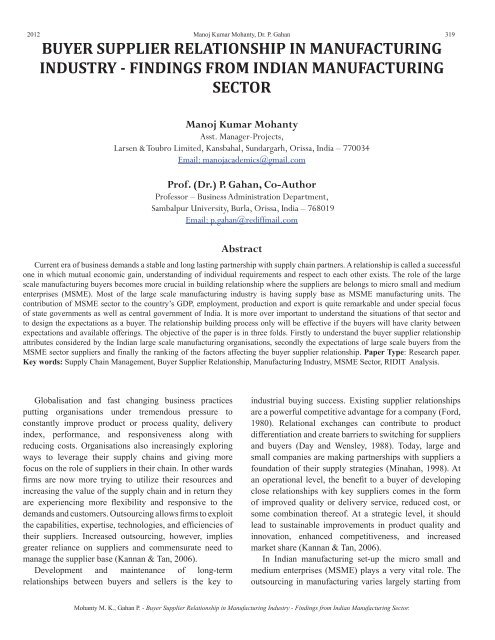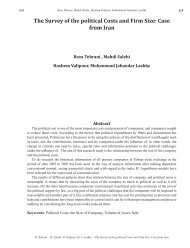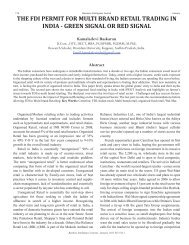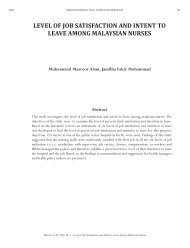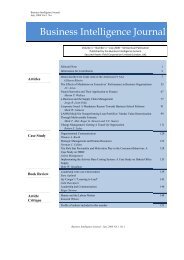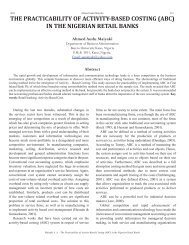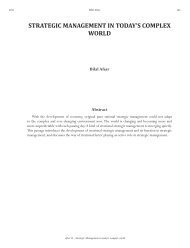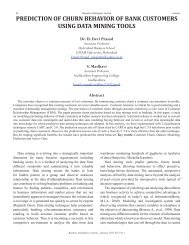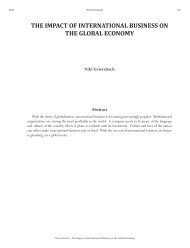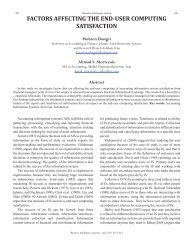buyer supplier relationship in manufacturing industry - Sayco
buyer supplier relationship in manufacturing industry - Sayco
buyer supplier relationship in manufacturing industry - Sayco
Create successful ePaper yourself
Turn your PDF publications into a flip-book with our unique Google optimized e-Paper software.
2012 Manoj Kumar Mohanty, Dr. P. Gahan319BUYER SUPPLIER RELATIONSHIP IN MANUFACTURINGINDUSTRY - FINDINGS FROM INDIAN MANUFACTURINGSECTORManoj Kumar MohantyAsst. Manager-Projects,Larsen & Toubro Limited, Kansbahal, Sundargarh, Orissa, India – 770034Email: manojacademics@gmail.comProf. (Dr.) P. Gahan, Co-AuthorProfessor – Bus<strong>in</strong>ess Adm<strong>in</strong>istration Department,Sambalpur University, Burla, Orissa, India – 768019Email: p.gahan@rediffmail.comAbstractCurrent era of bus<strong>in</strong>ess demands a stable and long last<strong>in</strong>g partnership with supply cha<strong>in</strong> partners. A <strong>relationship</strong> is called a successfulone <strong>in</strong> which mutual economic ga<strong>in</strong>, understand<strong>in</strong>g of <strong>in</strong>dividual requirements and respect to each other exists. The role of the largescale manufactur<strong>in</strong>g <strong>buyer</strong>s becomes more crucial <strong>in</strong> build<strong>in</strong>g <strong>relationship</strong> where the <strong>supplier</strong>s are belongs to micro small and mediumenterprises (MSME). Most of the large scale manufactur<strong>in</strong>g <strong>in</strong>dustry is hav<strong>in</strong>g supply base as MSME manufactur<strong>in</strong>g units. Thecontribution of MSME sector to the country’s GDP, employment, production and export is quite remarkable and under special focusof state governments as well as central government of India. It is more over important to understand the situations of that sector andto design the expectations as a <strong>buyer</strong>. The <strong>relationship</strong> build<strong>in</strong>g process only will be effective if the <strong>buyer</strong>s will have clarity betweenexpectations and available offer<strong>in</strong>gs. The objective of the paper is <strong>in</strong> three folds. Firstly to understand the <strong>buyer</strong> <strong>supplier</strong> <strong>relationship</strong>attributes considered by the Indian large scale manufactur<strong>in</strong>g organisations, secondly the expectations of large scale <strong>buyer</strong>s from theMSME sector <strong>supplier</strong>s and f<strong>in</strong>ally the rank<strong>in</strong>g of the factors affect<strong>in</strong>g the <strong>buyer</strong> <strong>supplier</strong> <strong>relationship</strong>. Paper Type: Research paper.Key words: Supply Cha<strong>in</strong> Management, Buyer Supplier Relationship, Manufactur<strong>in</strong>g Industry, MSME Sector, RIDIT Analysis.Globalisation and fast chang<strong>in</strong>g bus<strong>in</strong>ess practicesputt<strong>in</strong>g organisations under tremendous pressure toconstantly improve product or process quality, delivery<strong>in</strong>dex, performance, and responsiveness along withreduc<strong>in</strong>g costs. Organisations also <strong>in</strong>creas<strong>in</strong>gly explor<strong>in</strong>gways to leverage their supply cha<strong>in</strong>s and giv<strong>in</strong>g morefocus on the role of <strong>supplier</strong>s <strong>in</strong> their cha<strong>in</strong>. In other wardsfirms are now more try<strong>in</strong>g to utilize their resources and<strong>in</strong>creas<strong>in</strong>g the value of the supply cha<strong>in</strong> and <strong>in</strong> return theyare experienc<strong>in</strong>g more flexibility and responsive to thedemands and customers. Outsourc<strong>in</strong>g allows firms to exploitthe capabilities, expertise, technologies, and efficiencies oftheir <strong>supplier</strong>s. Increased outsourc<strong>in</strong>g, however, impliesgreater reliance on <strong>supplier</strong>s and commensurate need tomanage the <strong>supplier</strong> base (Kannan & Tan, 2006).Development and ma<strong>in</strong>tenance of long-term<strong>relationship</strong>s between <strong>buyer</strong>s and sellers is the key to<strong>in</strong>dustrial buy<strong>in</strong>g success. Exist<strong>in</strong>g <strong>supplier</strong> <strong>relationship</strong>sare a powerful competitive advantage for a company (Ford,1980). Relational exchanges can contribute to productdifferentiation and create barriers to switch<strong>in</strong>g for <strong>supplier</strong>sand <strong>buyer</strong>s (Day and Wensley, 1988). Today, large andsmall companies are mak<strong>in</strong>g partnerships with <strong>supplier</strong>s afoundation of their supply strategies (M<strong>in</strong>ahan, 1998). Atan operational level, the benefit to a <strong>buyer</strong> of develop<strong>in</strong>gclose <strong>relationship</strong>s with key <strong>supplier</strong>s comes <strong>in</strong> the formof improved quality or delivery service, reduced cost, orsome comb<strong>in</strong>ation thereof. At a strategic level, it shouldlead to susta<strong>in</strong>able improvements <strong>in</strong> product quality and<strong>in</strong>novation, enhanced competitiveness, and <strong>in</strong>creasedmarket share (Kannan & Tan, 2006).In Indian manufactur<strong>in</strong>g set-up the micro small andmedium enterprises (MSME) plays a very vital role. Theoutsourc<strong>in</strong>g <strong>in</strong> manufactur<strong>in</strong>g varies largely start<strong>in</strong>g fromMohanty M. K., Gahan P. - Buyer Supplier Relationship <strong>in</strong> Manufactur<strong>in</strong>g Industry - F<strong>in</strong>d<strong>in</strong>gs from Indian Manufactur<strong>in</strong>g Sector.
2012 Manoj Kumar Mohanty, Dr. P. Gahan321Narayandas, 1995). Exploit the capabilities, expertise,technologies, and efficiencies of their <strong>supplier</strong>s are the ma<strong>in</strong>objective of outsourc<strong>in</strong>g. Increased outsourc<strong>in</strong>g, however,implies greater reliance on <strong>supplier</strong>s and a commensurateneed to, manage the <strong>supplier</strong> base. This has for somecompanies meant reduc<strong>in</strong>g and streaml<strong>in</strong><strong>in</strong>g the <strong>supplier</strong>base, and/or develop<strong>in</strong>g closer <strong>relationship</strong>s with <strong>supplier</strong>s(Scannell et al., 2000).Relationship is not a uni-dimensional construct.Campbell (1997) def<strong>in</strong>ed four types of <strong>relationship</strong>;self-cantered (characterized by a focus on firm needs),personal loyalty (mutual responsibility and commitment),mutual <strong>in</strong>vestment (long-term commitment for strategicadvantage), and political control (mutual dependence andhigh levels of <strong>in</strong>tegration). O’Toole and Donaldson (2000)def<strong>in</strong>ed <strong>relationship</strong>s as bilateral (characterized by mutualcooperation), recurrent (close but absent the closeness ofa bilateral <strong>relationship</strong>), discrete (m<strong>in</strong>imal <strong>in</strong>teraction),or hierarchical (one partner is dom<strong>in</strong>ant). Evidence fromthe literature on strategic <strong>supplier</strong> alliances, a particularmanifestation of a long-term, collaborative <strong>relationship</strong>,suggests that <strong>buyer</strong>s tend to prefer closer <strong>relationship</strong>swhen they wish to control the dependability of supply or<strong>in</strong>fluence <strong>supplier</strong> quality and delivery schedules (Ellram,1995). Secure long-term, reliable markets, or to <strong>in</strong>fluencecustomer quality are the factors through <strong>supplier</strong>s can bemotivated.Increased supply management orientation by the<strong>buyer</strong> i.e. long-term perspective <strong>in</strong> <strong>supplier</strong> <strong>relationship</strong>s,<strong>supplier</strong> <strong>in</strong>volvement <strong>in</strong> product development, <strong>supplier</strong>reduction programs and quality focus <strong>in</strong> <strong>supplier</strong> selectionimproves both <strong>buyer</strong> and <strong>supplier</strong> performance relatedto quality, delivery and cost (Sh<strong>in</strong>, 2000). Frolich andWestbrook (2001) f<strong>in</strong>d that firms <strong>in</strong>tegrated at bothcustomer and <strong>supplier</strong> sides tend to improve marketplace,productivity and non-productivity performance (Li ,2006)Organizations adopt<strong>in</strong>g supply cha<strong>in</strong> management practiceslike strategic <strong>supplier</strong> partnerships, customer <strong>relationship</strong>s,<strong>in</strong>formation shar<strong>in</strong>g and postponement reach high levels oforganizational performance (Li, 2006).With<strong>in</strong> the SME doma<strong>in</strong> it is argued that most SMEs whowant to build <strong>relationship</strong>s often lack track record <strong>in</strong> termsof notable credibility signalled by reputation and characterendorsements (Prahalad and Hamel, 1990) Accord<strong>in</strong>gto Blois (1999), flexible conditions enable the creationof tolerance towards behavioural and environmentaluncerta<strong>in</strong>ty and engender trust, which <strong>in</strong> turn gives room tothe <strong>relationship</strong> to cont<strong>in</strong>ue. There is positively co-relationbetween cooperation and satisfaction (Dwyer, 1980).The cooperation factor results <strong>in</strong> to trust, commitmentand efficiency among <strong>buyer</strong> and <strong>supplier</strong>. Service qualityand satisfaction l<strong>in</strong>ked with each other (Parasuraman,1994). The behavioural attributes of manufactur<strong>in</strong>gorganisations also deliver satisfaction (Moorman, 1992).Firms must understand their cha<strong>in</strong> partners <strong>in</strong> all respects,<strong>in</strong>clud<strong>in</strong>g comprehension of the sources, imbalances, andconsequences of power such that the most beneficial use(or disuse) of this power can be directed to achieve supplycha<strong>in</strong> performance and member satisfaction (Benton,Maloni, 2005)Importance of Indian MSME IndustyMicro, Small and Medium Enterprises (MSMEs)enterprises generat<strong>in</strong>g the highest rates of employmentgrowth, account for a major share of <strong>in</strong>dustrial productionand exports along with key role <strong>in</strong> the economic developmentof the country. MSME sector avails the focus from stategovernments as well as central government of India. Bothstate and central government encourages entrepreneurship,employment and livelihood opportunities and enhancethe competitiveness of MSMEs <strong>in</strong> the changed economicscenario. As per the annual report of Government of IndiaM<strong>in</strong>istry of Micro, Small and Medium Enterprises (2009-10) the micro, small and medium enterprises (MSME)sector contributes significantly to the manufactur<strong>in</strong>g output,employment and exports of the country. It is estimated that<strong>in</strong> terms of value, the sector accounts for about 45 per centof the manufactur<strong>in</strong>g output and 40 per cent of the totalexports of the country.As per Indian <strong>in</strong>dustry act, 2006 the category of the<strong>in</strong>dustries def<strong>in</strong>ed as per the plant and mach<strong>in</strong>ery <strong>in</strong>vestmentmade (Exclud<strong>in</strong>g land and build<strong>in</strong>gs) by the organisation.The detail def<strong>in</strong>itions expla<strong>in</strong>ed <strong>in</strong> the table no.1.Table.1 - Def<strong>in</strong>ition of Micro, Small and Medium IndustryInvestment <strong>in</strong> plant and mach<strong>in</strong>ery/equipment (exclud<strong>in</strong>gland and build<strong>in</strong>g)Manufactur<strong>in</strong>g Enterprises Service EnterprisesMicro Up to Rs. 25 Lakh Up to Rs. 10 LakhSmallMediumMore than Rs. 25 Lakhand up to Rs. 5 croreMore than Rs. 5 crore andup to Rs. 10 croreMore than Rs. 10 Lakh andup to Rs. 2 croreMore than Rs. 2 crore andup to Rs. 5 croreSource : Annual Report (2006-2007)of M<strong>in</strong>istry of Small scale Industries,IndiaMohanty M. K., Gahan P. - Buyer Supplier Relationship <strong>in</strong> Manufactur<strong>in</strong>g Industry - F<strong>in</strong>d<strong>in</strong>gs from Indian Manufactur<strong>in</strong>g Sector.
2012 Manoj Kumar Mohanty, Dr. P. Gahan323one organisation has on another: (a) the importance of therequired specific resource, (b) the extent to which one partyexercises control over the resources, and (c) the extent ofavailable alternatives or substitutes. Small and mediumenterprises have been found to be particularly <strong>in</strong>fluencedby the personal and social acqua<strong>in</strong>tances of the ownersand managers (Dickson and Hadjimanolis, 1998). Buyer<strong>supplier</strong> <strong>relationship</strong> also carries a governance mechanismto safeguard the opportunistic and unfaithful act of<strong>supplier</strong>s. Buyers always expect trust, commitment andadaptation from the <strong>supplier</strong>s. Those <strong>supplier</strong>s who alwaysexhibit such attitudes are preferred long term <strong>supplier</strong>sfor the organisations. Product knowledge, Process knowhow,eng<strong>in</strong>eer<strong>in</strong>g draw<strong>in</strong>g read<strong>in</strong>g ability, documentationability is the key qualify<strong>in</strong>g factors for select<strong>in</strong>g a <strong>supplier</strong>and cont<strong>in</strong>u<strong>in</strong>g <strong>relationship</strong>. Adherence to the governmentrules, regulations, safe acts, good labour practices are alsodesirable from <strong>supplier</strong>s. Quality <strong>in</strong> the product, process,and delivery schedule adherence goes <strong>in</strong> the prime listwithout say<strong>in</strong>g. Almost all experts gave emphasis on trust,loyalty, accommodative behaviour, technical capability fora stronger <strong>buyer</strong> <strong>supplier</strong> <strong>relationship</strong>. Partnership approach,conflict management, fairness <strong>in</strong> order management andorganisational strategy also found to be contribut<strong>in</strong>g factorsfor build<strong>in</strong>g strong <strong>buyer</strong> <strong>supplier</strong> <strong>relationship</strong>. Based onthese factors questionnaire is prepared and tested on thesamples to get the actual feel<strong>in</strong>g of the <strong>buyer</strong>s regard<strong>in</strong>g the<strong>buyer</strong> <strong>supplier</strong> contribut<strong>in</strong>g factors.Research MethodologyThis research work carried out <strong>in</strong> the manufactur<strong>in</strong>g<strong>in</strong>dustries of Orissa, one of the most fast develop<strong>in</strong>g<strong>in</strong>dustrial states of India. To avoid the biasness we havetaken survey of the four large scale manufactur<strong>in</strong>g<strong>in</strong>dustries <strong>in</strong> Orissa. This research work carried out <strong>in</strong>two phases. Initially to get the <strong>buyer</strong> <strong>supplier</strong> <strong>relationship</strong>attributes <strong>in</strong> such type of <strong>in</strong>dustry different resources used.Attributes of <strong>buyer</strong> <strong>supplier</strong> <strong>relationship</strong>s made based on theliterature review, export op<strong>in</strong>ions and work<strong>in</strong>g experienceof the authors. Dur<strong>in</strong>g the exploration of <strong>buyer</strong> <strong>supplier</strong><strong>relationship</strong> attributes we have selected 14 <strong>buyer</strong> headsfrom four large scale manufactur<strong>in</strong>g <strong>in</strong>dustries too, whoseorganisations <strong>in</strong>voic<strong>in</strong>g figure is more than 4000 million.These experienced <strong>buyer</strong>s are hav<strong>in</strong>g average 22 years ofbuy<strong>in</strong>g experience <strong>in</strong> deal<strong>in</strong>g with MSME sector. The secondphase is selection of samples. The developed questionnairetested on the <strong>buyer</strong>s work<strong>in</strong>g on those four large scalemanufactur<strong>in</strong>g <strong>in</strong>dustries whose work<strong>in</strong>g experience morethan five years with MSME sector <strong>supplier</strong>s. Buyer heads ofthose organisations were excluded dur<strong>in</strong>g sample selection.Initially 120 structured questionnaires (Attached asAnnexure-II) sent for collection of data. Only a sampleof size 82 is collected by E-mail and personal <strong>in</strong>teractionsdepend<strong>in</strong>g upon the location of the <strong>buyer</strong>s. A usable sampleof 78 is considered for analysis, rest 4 are rejected for<strong>in</strong>complete <strong>in</strong>formation. The questionnaire is designed us<strong>in</strong>gfive po<strong>in</strong>t Likert scales where 1 meant strong disagreementand 5 mean strong agreement with a particular attribute of<strong>buyer</strong> <strong>supplier</strong> <strong>relationship</strong>. RIDIT analysis applied on theavailable data for data analysis and review.Theroretical FrameworkBus<strong>in</strong>ess <strong>relationship</strong> stands on understand<strong>in</strong>gs ofmutual bus<strong>in</strong>ess needs, benefits and s<strong>in</strong>cere wish to cont<strong>in</strong>ue<strong>relationship</strong> for the common shared objective. The mostimportant element of the supply cha<strong>in</strong> is <strong>buyer</strong>-<strong>supplier</strong><strong>relationship</strong>s. A susta<strong>in</strong>able and effective <strong>relationship</strong> is theprerequisite of organisational success.The priorities likeresource maximization, <strong>in</strong>vestments, time and regulatorycompliance may force the <strong>relationship</strong> <strong>in</strong>to stressed zone.The role of organizations is to make a balance of mutualexpectations and to address the issues well with<strong>in</strong> time frameso that healthy <strong>relationship</strong> between buy<strong>in</strong>g organizationand sell<strong>in</strong>g organization can prevail.From the literature and the primary survey conductedthrough large scale <strong>buyer</strong> heads it is very clear that the <strong>buyer</strong><strong>supplier</strong> <strong>relationship</strong> is based on trust, mutual respect foreach other, understand<strong>in</strong>g, communication, <strong>in</strong>terpersonal<strong>relationship</strong>, cooperation, partnership approach, fairness<strong>in</strong> order management, conflict management, technicalcapability of the <strong>supplier</strong>, organizational strategy knowhowof the <strong>buyer</strong> and power-dependence.Mohanty M. K., Gahan P. - Buyer Supplier Relationship <strong>in</strong> Manufactur<strong>in</strong>g Industry - F<strong>in</strong>d<strong>in</strong>gs from Indian Manufactur<strong>in</strong>g Sector.
2012 Manoj Kumar Mohanty, Dr. P. Gahan325TrustCapacity & Capability of SupplierTrust <strong>in</strong>dicates “a person’s reputation for trustworth<strong>in</strong>esson both a professional and personallevel as well as credibility <strong>in</strong> a bus<strong>in</strong>ess situation”(Woo and Phrud'homme 1999). Trust is a factor whichshould flow from both the sides. Based on the trust both theparties can manage the down time of bus<strong>in</strong>ess, conflict<strong>in</strong>gsituations, profitability issues, market management and <strong>in</strong>reality all the aspects of the bus<strong>in</strong>ess. Literatures witnesseddecrease <strong>in</strong> product cost, risk reduction and shar<strong>in</strong>g, longterm <strong>relationship</strong>s, <strong>in</strong>vestment opportunities and furtherexpansion of bus<strong>in</strong>ess <strong>relationship</strong>s through trust.Power and DependencyThe fundamental assumption of all portfolio modelsseems to be the occurrence of differences <strong>in</strong> power anddependence between <strong>buyer</strong>s and <strong>supplier</strong>s (Dubois andPedersen, 2002). Usually power structure described as theexploit power of the <strong>buyer</strong>. Buyers go for diversification toreduce the power of <strong>supplier</strong> or to reduce the dependability.General idea of the portfolio approach is to m<strong>in</strong>imize supplyvulnerability and make the most of potential buy<strong>in</strong>g power(Kraljic, 1983). The power and dependency differs <strong>in</strong> eachquarter of the purchas<strong>in</strong>g portfolio. The dependency on the<strong>supplier</strong>s varies from firm to firm and situation to situationand vice versa. The dependency of <strong>buyer</strong> becomes thepower source for <strong>supplier</strong> and the dependency of <strong>supplier</strong>becomes the power source for <strong>buyer</strong>. Basically power anddependency are relative terms and the magnitude varieswith organization and situation.The Buchanan (1992) conceptualized powerdependenceimbalances <strong>in</strong> <strong>buyer</strong>–<strong>supplier</strong> <strong>relationship</strong>s asthe difference <strong>in</strong> value that <strong>buyer</strong>s and sellers attach to the<strong>relationship</strong>. Independent partner dom<strong>in</strong>ate the exchangeand vice versa. A <strong>relationship</strong> is balanced where the<strong>buyer</strong> and <strong>supplier</strong> shares a non-dom<strong>in</strong>at<strong>in</strong>g environment.Imbalance <strong>relationship</strong> due to unbalanced power shar<strong>in</strong>gcan lead to stressed <strong>relationship</strong>, non-productivity and ashorter <strong>relationship</strong> life. Relationship largely depends uponthe <strong>in</strong>tensity of the <strong>in</strong>terdependency. The positive <strong>in</strong>tensitycould lead to stronger <strong>relationship</strong>, long term association;mutual trust, commitment and can also open-up possibilitiesfor further degree of bus<strong>in</strong>ess association and <strong>in</strong>vestmentopportunities.When <strong>supplier</strong> selection considered <strong>in</strong> operationalterms, then these two words are the best describer of the<strong>supplier</strong>s. In real terms capacity to execute and capabilityto handle order and complete is the strength of the <strong>supplier</strong>.One of the very reasons of hav<strong>in</strong>g <strong>relationship</strong> with <strong>supplier</strong>is to exploit the capacity and capability of the <strong>supplier</strong>for the organizations goal. This is one of the pr<strong>in</strong>cipalrequirements. due course of the <strong>relationship</strong> the OEM canand should <strong>in</strong>crease the capacity and capability like processknowledge, process improvement, special mach<strong>in</strong>es, tools,tackles, hands on experience of the man power at <strong>supplier</strong>end. In the manufactur<strong>in</strong>g <strong>in</strong>dustries <strong>buyer</strong>s organizespecial skill set improvement plan to improve the skill ofthe <strong>supplier</strong>'s manpower. Advanced mach<strong>in</strong><strong>in</strong>g knowledge,advanced weld<strong>in</strong>g technology, mold<strong>in</strong>g processes, latestmeasur<strong>in</strong>g <strong>in</strong>struments, correct assembly process, latesttools used for manufactur<strong>in</strong>g also a part of build<strong>in</strong>g strengthat <strong>supplier</strong>'s end. Government rules, safety featured,environment policies implementation also taken care byOEM organization for <strong>supplier</strong>s.CommunicationsCommunication is one of the essential components <strong>in</strong>the <strong>buyer</strong> <strong>supplier</strong> <strong>relationship</strong>. Communication may berelated to product price, contractual agreements, technicalspecifications, organizational strategy and may be marketrelated know-how. Communication can only be effective ifboth the parties understand the requirement of each other and<strong>in</strong> the same level of th<strong>in</strong>k<strong>in</strong>g & understand<strong>in</strong>g. Accord<strong>in</strong>gto Mohr and Nev<strong>in</strong> (1990), there are four categories ofcommunication: content, way, feedback and frequency.These categories will shape the com¬munication <strong>in</strong>tensityand the <strong>in</strong>tegration between <strong>supplier</strong>-<strong>buyer</strong>.PartnershipAdversarial competitive and collaborative partnershipare the two aspects of <strong>buyer</strong> <strong>supplier</strong> <strong>relationship</strong> andthese two aspects represents old fashion and currentfashion work<strong>in</strong>g style of purchas<strong>in</strong>g managers. Traditionaladversarial approach is to m<strong>in</strong>imize the price of purchasedgoods and services whereas trust, commitment, longterm <strong>relationship</strong> and risk shar<strong>in</strong>g are the elements ofMohanty M. K., Gahan P. - Buyer Supplier Relationship <strong>in</strong> Manufactur<strong>in</strong>g Industry - F<strong>in</strong>d<strong>in</strong>gs from Indian Manufactur<strong>in</strong>g Sector.
328 Bus<strong>in</strong>ess Intelligence Journal JulyTable-6 represents the Ridit for Reference data set. Thedata are tabulated accord<strong>in</strong>g to their score <strong>in</strong> terms of thelikert scale. The πi jis 78, as the total sample taken is 78.We have calculated the f i, F j, and R j.Respondents strongly agree to variables like Knowledgeof Purchas<strong>in</strong>g Strategy, Supplier Selection Criteria, Fairness,Order Clarity, Trust, and Confidentiality for build<strong>in</strong>g <strong>buyer</strong><strong>supplier</strong> <strong>relationship</strong>. They have strongly disagree tovariable like Transparency In order communication, Equalopportunity, Early Supplier Involvement <strong>in</strong> <strong>relationship</strong>build<strong>in</strong>g.Table.7 - Ridits for the Comparison Data SetsVAR SA (5) A(4) N(3) D(2) SD(1) ρ iLB UB1 0.04 0.22 0.04 0.02 0.01 0.33 0.26 0.402 0.02 0.15 0.18 0.14 0.05 0.53 0.46 0.603 0.04 0.17 0.02 0.07 0.03 0.33 0.26 0.404 0.01 0.08 0.25 0.23 0.11 0.67 0.60 0.745 0.02 0.25 0.04 0.09 0.03 0.42 0.35 0.496 0.00 0.14 0.25 0.16 0.08 0.63 0.56 0.707 0.02 0.26 0.09 0.05 0.00 0.41 0.34 0.488 0.01 0.21 0.13 0.11 0.13 0.57 0.50 0.649 0.03 0.16 0.16 0.02 0.00 0.38 0.31 0.4510 0.03 0.20 0.02 0.07 0.05 0.37 0.30 0.4411 0.07 0.07 0.05 0.00 0.00 0.20 0.13 0.2712 0.03 0.16 0.18 0.00 0.00 0.38 0.31 0.4513 0.04 0.13 0.13 0.09 0.00 0.39 0.32 0.4614 0.01 0.22 0.18 0.08 0.00 0.49 0.42 0.5615 0.02 0.21 0.13 0.09 0.00 0.44 0.37 0.5116 0.01 0.10 0.07 0.47 0.03 0.68 0.61 0.7517 0.02 0.19 0.16 0.07 0.00 0.44 0.37 0.5118 0.00 0.21 0.23 0.09 0.05 0.58 0.51 0.6519 0.02 0.14 0.20 0.11 0.03 0.50 0.43 0.5720 0.01 0.07 0.04 0.36 0.30 0.78 0.71 0.8521 0.01 0.08 0.13 0.36 0.15 0.72 0.65 0.7922 0.01 0.03 0.25 0.36 0.13 0.77 0.70 0.8423 0.03 0.24 0.00 0.07 0.00 0.34 0.27 0.4124 0.01 0.07 0.12 0.39 0.08 0.67 0.60 0.7425 0.01 0.10 0.16 0.38 0.00 0.66 0.59 0.7326 0.03 0.23 0.00 0.05 0.05 0.35 0.28 0.4227 0.03 0.17 0.18 0.02 0.00 0.40 0.33 0.4728 0.04 0.19 0.09 0.02 0.00 0.34 0.27 0.4129 0.01 0.14 0.16 0.27 0.05 0.63 0.56 0.7030 0.02 0.23 0.02 0.16 0.00 0.42 0.35 0.4931 0.01 0.27 0.07 0.14 0.00 0.48 0.41 0.5532 0.02 0.17 0.09 0.23 0.00 0.51 0.44 0.58VAR SA (5) A(4) N(3) D(2) SD(1) ρ iLB UB33 0.02 0.17 0.14 0.16 0.00 0.49 0.42 0.5634 0.01 0.10 0.27 0.25 0.03 0.65 0.58 0.7235 0.01 0.21 0.25 0.05 0.00 0.51 0.44 0.58Note: SA: Strongly Agree, A: Agree, N: Neither Disagree nor Agree,D: Disagree, SD: Strongly Disagree, LB: Lower Boundary, UB: UpperBoundary.Table.8 - Rank<strong>in</strong>g of Quality Attributes <strong>in</strong> Buyer SupplierRelationshipVar Description Ridit Value Rank<strong>in</strong>g11 Order Clarity 0.20 11 Knowledge of Purchas<strong>in</strong>g Strategy 0.33 23 Supplier Selection Criteria 0.33 323 Dependability 0.34 428 Competitiveness 0.34 526 Partnership Approach 0.35 610 System Driven 0.37 79 Fairness 0.38 812 Trust 0.38 913 Confidentiality 0.39 1027 Supplier Development Attitude 0.40 117 Product & Process Knowledge 0.41 125 Communication 0.42 1330 Flexibility 0.42 1415 Restriction to Back door sell<strong>in</strong>g 0.44 1517 Infrastructure Development 0.44 1631 Periodic Review of Situation 0.48 1714 Believe 0.49 1833 Justice 0.49 1919 Technical Tra<strong>in</strong><strong>in</strong>g 0.50 2032 Decision with Reason 0.51 2135 Accommodative 0.51 222 Review of purchas<strong>in</strong>g strategy 0.53 238 Transparency In order Management 0.57 2418 F<strong>in</strong>ancial Assistance 0.58 256 Evaluation Clarity 0.63 2629 Personal Relationship with Buyer 0.63 2734 Grievance Handl<strong>in</strong>g 0.65 2825 Extended Organisation 0.66 294 Buyer Competency 0.67 3024 Transparent deal 0.67 3116 Opportunist Behaviour 0.68 3221 Suggestion Acceptance 0.72 3322 Resourcefulness 0.77 3420 Early Supplier Involvement 0.78 35Bus<strong>in</strong>ess Intelligence Journal - July, 2012 Vol.5 No.2
2012 Manoj Kumar Mohanty, Dr. P. Gahan329Table 8 expla<strong>in</strong>s about the rank<strong>in</strong>g of different factors.From the Ridit analysis a direct sort<strong>in</strong>g of mean Ridits <strong>in</strong>terms of the probability of be<strong>in</strong>g <strong>in</strong> agree<strong>in</strong>g propensitygives the rank<strong>in</strong>g as mentioned <strong>in</strong> Table-8, that highlightssignificant factors (rank<strong>in</strong>g) affect<strong>in</strong>g the <strong>buyer</strong>-<strong>supplier</strong><strong>relationship</strong> accord<strong>in</strong>g to the respondents’ op<strong>in</strong>ion.The front l<strong>in</strong>e factors which are contribut<strong>in</strong>g to the <strong>buyer</strong><strong>supplier</strong> <strong>relationship</strong> as per the respondents are clarity <strong>in</strong>order management, knowledge of purchas<strong>in</strong>g strategyby the <strong>buyer</strong>s, <strong>supplier</strong> selection criteria, dependability,competitiveness, partnership approach. Factors are hav<strong>in</strong>glow impact <strong>in</strong> <strong>buyer</strong> <strong>supplier</strong> <strong>relationship</strong> are found to beEarly Supplier Involvement of the <strong>supplier</strong>, resourcefulnessof <strong>supplier</strong>, suggestion acceptance, opportunist Behaviour,transparent deal, <strong>buyer</strong> competency.Clarity <strong>in</strong> order management creates faith towards the<strong>buyer</strong> and the buy<strong>in</strong>g organisation. Supplier’s feel they willnot be cheated <strong>in</strong> anyway by deal<strong>in</strong>g with the organisation.They feel term and conditions mentioned <strong>in</strong> the order,payment terms and other contractual obligations more orless will be fair. As <strong>buyer</strong>s are the common po<strong>in</strong>t of contactfor <strong>supplier</strong>s the knowledge of purchas<strong>in</strong>g strategy is veryessential for the <strong>buyer</strong>. Once <strong>buyer</strong> is clear about that he/she will communicate proper massage to the <strong>supplier</strong>s, sothat clarity <strong>in</strong> the thought and action will be there. Supplierselection criteria also have enough impact on the <strong>relationship</strong>.Organisations can only have a proper <strong>relationship</strong> if theycan select the correct <strong>supplier</strong> base based on their strategicand functional requirement. Dependability is a word ofmutual understand<strong>in</strong>g and fulfill<strong>in</strong>g of the <strong>in</strong>dividualobjectives. The <strong>in</strong>tensity of the <strong>relationship</strong> is also dependsupon dependability. Competitive environment also helps <strong>in</strong>creat<strong>in</strong>g <strong>relationship</strong>. This reduces the monopoly and createsa healthy environment. No doubt partnership approach is astrong tool for ma<strong>in</strong>ta<strong>in</strong><strong>in</strong>g <strong>relationship</strong>. Once the buy<strong>in</strong>gorganisation and sell<strong>in</strong>g organisation understands eachother’s position <strong>in</strong> the supply cha<strong>in</strong>, then actions can be<strong>in</strong>itiated to reduce the risk, shar<strong>in</strong>g the process and productknowledge and market place.Summary & ConclusionBuyer <strong>supplier</strong> <strong>relationship</strong> largely depends upon fourmajor aspects. They are strategic requirements of theorganisation, <strong>supplier</strong> performance, mode of operation andpersonal factors. Strategic issues may be who to choose as apartner and for what type of product or service. Performancemay be cost, quality, delivery and related issues. Mode ofoperation may be pric<strong>in</strong>g structure, <strong>in</strong>formation exchangelevels, technology <strong>in</strong>terchange, bus<strong>in</strong>ess area, Productor process. Personal factors will be trust, commitment,loyalty, openness, attitude, flexibility etc. out of these fourfactors only personal factor is qualitative and rest three arequantitative.From the survey it is cleared that the mode of operationtak<strong>in</strong>g high priority <strong>in</strong> the <strong>relationship</strong> build<strong>in</strong>g like clarity<strong>in</strong> order management, <strong>buyer</strong>’s know-how <strong>in</strong> purchas<strong>in</strong>gstrategy, Supplier Selection Criteria, Competitiveness,Partnership Approach, Dependability. The role of <strong>buyer</strong>’sis considered to be more critical <strong>in</strong> mak<strong>in</strong>g a healthy <strong>buyer</strong><strong>supplier</strong> <strong>relationship</strong> as <strong>in</strong> operational situation only <strong>buyer</strong>becomes the <strong>in</strong>terface of <strong>supplier</strong>. The survey also revealsthat transparent deal, opportunist Behaviour, suggestionacceptance, resourcefulness of <strong>buyer</strong> and Early SupplierInvolvement are hav<strong>in</strong>g low impact <strong>in</strong> the <strong>relationship</strong>.These factors are additional factors <strong>in</strong> the <strong>relationship</strong>,which may add value to the <strong>relationship</strong> but not necessarilyaffect the <strong>relationship</strong>. Organisation must take a stock of<strong>buyer</strong> <strong>relationship</strong> status <strong>in</strong> regular <strong>in</strong>tervals to know thestrength of the <strong>relationship</strong>. Suppliers may be contacted<strong>in</strong>dividually to know the required operational flexibility.The tra<strong>in</strong><strong>in</strong>g of the <strong>buyer</strong>s on <strong>relationship</strong> mak<strong>in</strong>g with<strong>in</strong>the strategic walls can play a major role <strong>in</strong> strengthen<strong>in</strong>g the<strong>relationship</strong>. Buyers can be selected based on their soft skilland attitude, so that they can understand and implementsuitably the mean<strong>in</strong>g of term like trust, commitment, andloyalty for the <strong>relationship</strong> build<strong>in</strong>g.ReferencesA Parasuraman, Zeithaml, V. and Berry L (1994), “Reassessment of expectationsas a comparision standard<strong>in</strong> measur<strong>in</strong>g consumer perceptions of service quality :Implications for future research”, Journal of Market<strong>in</strong>g,Vol, 58, January, PP. 11-24.Day, G.S. and Wensley, R. (1988), “Assess<strong>in</strong>g advantage:a framework for diagnos<strong>in</strong>g competitive superiority”,Journal of Market<strong>in</strong>g, Vol. 52 No. 1, pp. 1-20.Ford, D. (1980), “The development of <strong>buyer</strong>-seller<strong>relationship</strong>s <strong>in</strong> <strong>in</strong>dustrial markets”, European Journalof Market<strong>in</strong>g, Vol. 14 Nos 5/6, pp. 339-53.M<strong>in</strong>ahan, T. (1998), “Is partner<strong>in</strong>g a shame?”, Purchas<strong>in</strong>g,June 4, pp. 68-9.Ford, D. (1980), “The development of <strong>buyer</strong>-seller<strong>relationship</strong>s <strong>in</strong> <strong>in</strong>dustrial markets”, European Journalof Market<strong>in</strong>g, Vol. 14 Nos 5/6, pp. 339-53.Vijay R. Kannan, Keah Choon Tan, Buyer-<strong>supplier</strong><strong>relationship</strong>s “The impact of <strong>supplier</strong> selection andMohanty M. K., Gahan P. - Buyer Supplier Relationship <strong>in</strong> Manufactur<strong>in</strong>g Industry - F<strong>in</strong>d<strong>in</strong>gs from Indian Manufactur<strong>in</strong>g Sector.
330 Bus<strong>in</strong>ess Intelligence Journal July<strong>buyer</strong>-<strong>supplier</strong> engagement on <strong>relationship</strong> and firmperformance”, 2006 - International Journal of PhysicalDistribution & Logistics Management Vol. 36 No. 10,2006 pp. 755-775Eisenhardt, K. M. (1989). Agency theory: An assessmentand review. Academy of Management Review, 14,57−74.Dyer, J. H., & S<strong>in</strong>gh, H. (1998). The relational view:Cooperative strategy and sources of<strong>in</strong>terorganizational competitive advantage. Academy ofManagement Review, 23, 660−679.Zeithaml, V. A. (1988). Consumer perceptions of price,quality, and value: A means-end model and synthesis ofevidence. Journal of Market<strong>in</strong>g, 52, 2−22.Walter, A., Müller, T. A., Helfert, G., & Ritter, T. (2003).Functions of <strong>in</strong>dustrial <strong>supplier</strong> <strong>relationship</strong>s and theirimpact on <strong>relationship</strong> quality. Industrial Market<strong>in</strong>gManagement, 32, 159−169.Mason-Jones, R., & Towill, D. R. (1999). Total cycle timecompression and the agile supply cha<strong>in</strong>. InternationalJournal of Production Economics, 62, 61−73.Ulaga, W. (2003). Captur<strong>in</strong>g value creation <strong>in</strong> bus<strong>in</strong>ess<strong>relationship</strong>s: A customer perspective. IndustrialMarket<strong>in</strong>g Management, 32, 677−693.Dyer, J. H., & Hatch, N. W. (2004). Us<strong>in</strong>g <strong>supplier</strong> networksto learn faster. MIT Sloan Management Review, 45,57−63.Kalwani, M.U., Narayandas, N., 1995. Long-termmanufacturer-<strong>supplier</strong> <strong>relationship</strong>s: do they pay off for<strong>supplier</strong> firms? Journal of Market<strong>in</strong>g 59, 1–16.Scannell, T.V., Vickery, S.K. and Dro¨ge, C.L. (2000),“Upstream supply cha<strong>in</strong> management and competitiveperformance the automotive supply <strong>in</strong>dustry”, Journalof Bus<strong>in</strong>ess Logistics, Vol. 21 No. 1, pp. 23-48.O’Toole, T. and Donaldson, B. (2000), “Relationshipgovernance structures and performance”,Journal ofMarket<strong>in</strong>g Management, Vol. 16, pp. 327-41.O’Toole, T. and Donaldson, B. (2002), “Relationshipperformance dimensions of <strong>buyer</strong>-<strong>supplier</strong> exchanges”,European Journal of Purchas<strong>in</strong>g & Supply Management,Vol. 8, pp. 197-207.Ellram, L.M. (1995), “Partner<strong>in</strong>g pitfalls and successfactors”, International Journal of Purchas<strong>in</strong>g andMaterials Management, Vol. 31 No. 2, pp. 36-44.Sh<strong>in</strong>, H., Collier, D.A., Wilson, D.D., 2000. Supplymanagement orientation and <strong>supplier</strong>/<strong>buyer</strong>performance. Journal of Operations Management 18,317–333.Frolich, T.M., Westbrook, R., 2001. Arcs of <strong>in</strong>tegration: an<strong>in</strong>ternational study of supply cha<strong>in</strong> strategies. Journal ofOperations Management 19 (2), 185–200.Li, S., Ragu-Nathan, B., Ragu-Nathan, T.S., Rao, S.S.,2006. The impact of supply cha<strong>in</strong> management oncompetitive advantage and organizational performance.Omega 34, 107–124.Dwyer, F. R, “Channel member satisfaction: laboratory<strong>in</strong>sights”, Journal of Retail<strong>in</strong>g, Vol.56, Summer (1980),PP. 59-74Blois, K.J. (1999), “Trust <strong>in</strong> bus<strong>in</strong>ess-to-bus<strong>in</strong>ess<strong>relationship</strong>s: an evaluation of its status”, Journal ofManagement Studies, Vol. 36 No. 2, pp. 197-215.Moorman, C., Zaltman, G. and Deshpande, R. (1992,“Relationships between providers ans users of market<strong>in</strong>gresearch: the dynamics of trust with<strong>in</strong> and betweenorganisations”, Journal of Market<strong>in</strong>g Research, Vol. 29,August, pp.314-329.Loasby, B.J. (1998) The organization of capabilities.Journal of Economic Behavior & Organization, 35:2,139-161.Dickson, K.E. and Hadjimanolis, A. (1998) Innovationand network<strong>in</strong>g amongst small manufactur<strong>in</strong>g firms<strong>in</strong> Cyprus. International Journal of EntrepreneurialBehaviour and Research, 4 :5-17.Cunn<strong>in</strong>gham, M.T. (1980) International market<strong>in</strong>g andpurchas<strong>in</strong>g of <strong>in</strong>dustrial goods - Features of a Europeanresearch project. European Journal of Market<strong>in</strong>g, 14:5/6,322-338.Pfeffer, J. and Salancik, G.R. (1978) The External Controlof Organizations - A Resource Dependence Perspective.New York: Harper & Row Publishers.Bross, I.D.J., 1981. Citation Classic, Number 24 ThisWeek’s Citation Classic, 15 June.M.C.J. Canie¨ls, C.J. Gelderman : Purchas<strong>in</strong>g strategies <strong>in</strong> theKraljic matrix—A power and dependence perspective/Journal of Purchas<strong>in</strong>g & Supply Management 11 (2005)141–155Woo, Hong Seng and Cel<strong>in</strong>e Phrud'homme (1999), "CultureCharacteristics Prevalent <strong>in</strong> The Ch<strong>in</strong>ese NegotiationProcess," European Bus<strong>in</strong>ess Review, 99 (5), 313-22.Dubois, A., Pedersen, A., 2002. Why <strong>relationship</strong>s do not fit<strong>in</strong>to purchas<strong>in</strong>g portfolio models: a comparison betweenthe portfolio and <strong>in</strong>dustrial network approaches.European Journal of Purchas<strong>in</strong>g & Supply Management8, 35–42.Buchanan, L., 1992. Vertical trade <strong>relationship</strong>s: the roleof dependence and symmetry <strong>in</strong> atta<strong>in</strong><strong>in</strong>g organizationalgoals. Journal of Market<strong>in</strong>g Research 29, 65–75.Bus<strong>in</strong>ess Intelligence Journal - July, 2012 Vol.5 No.2
2012 Manoj Kumar Mohanty, Dr. P. Gahan331Morgan, Robert M. and Hunt, Shelby D. (1994), “TheCommitment-Trust Theory ofRelationship Market<strong>in</strong>g,” Journal of Market<strong>in</strong>g, 58 (July)20-38.Ellram, Lisa. M., (1990) The Supplier Selection Decision<strong>in</strong> Strategic Partnerships.Journal of Purchas<strong>in</strong>g and Material Management 26, 8-14Mohr, J. Nev<strong>in</strong>, J.R. (1990). Communication strategies <strong>in</strong>market<strong>in</strong>g channels: a theoretical perspective. Journal ofMarket<strong>in</strong>g, vol. 54 nr. 4, pp. 36-51.Annexure – ICompute RIDITs and mean RIDITs forComparison Data Sets.Note that a comparison dataset is comprised of thefrequencies of responses for each category of a Likert scaleitem. S<strong>in</strong>ce there are m Likert scale items <strong>in</strong> this illustration,there will be m comparison datasets.• Compute ridit value rij for each category of scaleitems.rijRjxπij=πiRidit AlgorithmCompute RIDITs for the reference data set• Select a population to serve as a reference dataset. For a Likert scale survey, the reference dataset can be the total responses of the survey, if thepopulation cannot be easily identified.• Compute frequency f jfor each category ofresponses, Where 1, 2,......,j = n.• Compute mid-po<strong>in</strong>t accumulated frequency F jforeach category of responses.F1=1 fF1 =12j∑ − 11f1+ f k2 k = 1Where, j = 2,……n• Compute ridit value j R for each category ofresponses <strong>in</strong> the reference data set.F1 =Where j = 1, 2,…...nN is the total number of responses from the Likert scalesurvey of <strong>in</strong>terest. By def<strong>in</strong>ition, the expected value of R forthe reference data set is always 0.5.F jNWhere, i = 1,2,...... mπ ijis the frequency of category j for the i thscale item, andπ iis a short form for the summation of frequencies for scaleitem i across all categories, i.e.π =<strong>in</strong>∑k = 1• Compute mean ridit ρ ifor each Likert scale item.ρ =n∑πikir ikk = 1• Compute confidence <strong>in</strong>terval for ρi when the sizeof the reference data set is very large relative to thatof any comparison data set, the 95% confidence<strong>in</strong>terval of any ρi is:ρi±13π• Test the follow<strong>in</strong>g hypothesis us<strong>in</strong>g Kruskal-Wallisstatistics W:⎧H⎪⎨⎪⎩H00: ∀i,ρ: ∃i,ρm∑i=1iiii= 0.5≠ 0.5W = 12 π ( ρ − 0.5)i2Mohanty M. K., Gahan P. - Buyer Supplier Relationship <strong>in</strong> Manufactur<strong>in</strong>g Industry - F<strong>in</strong>d<strong>in</strong>gs from Indian Manufactur<strong>in</strong>g Sector.
332 Bus<strong>in</strong>ess Intelligence Journal JulyW follows a χ2 distribution with (m−1) degree of freedom.If 0 H cannot be accepted, exam<strong>in</strong>e the <strong>relationship</strong>s amongconfidence <strong>in</strong>tervals ofρ. The general rules for <strong>in</strong>terpret<strong>in</strong>gthe values ofρ are shown below.• A scale item with its ρ ivalue statistically deviatefrom 0.5 implies a significant difference <strong>in</strong> theresponse patterns between the reference data setand the comparison data set for the particularscale item. If the confidence <strong>in</strong>terval of ρ iconta<strong>in</strong>s0.5, then it is accepted that the ρ ivalue is notsignificantly deviate from 0.5.• A low value of ρ iis preferred over a high valueof ρ ibecause a low value of ρ i<strong>in</strong>dicates a lowprobability of be<strong>in</strong>g <strong>in</strong> a negative propensity.• The response patterns of scale items with overlappedconfidence <strong>in</strong>tervals of ρ are considered, amongthe respondents, to be statistically <strong>in</strong>different fromeach other.Annexure – IIQuestionnarie for Buyer Supplier RelationshipThis survey is conducted for the academics purpose only.Please answer the question based on the prevail<strong>in</strong>g practices of your organization.Rate the follow<strong>in</strong>g questions with a scale of 1 to 5. Put a circle mark aga<strong>in</strong>st the appropriate box. Logic beh<strong>in</strong>d thenumber<strong>in</strong>gs are5 = Strongly agree to the statement4 = Agree to the statement3 = Neutral to the statement2 = Disagree to the statement1 = Strongly disagree to the statementQ1 Organisational strategy for out sourc<strong>in</strong>g is known to all <strong>buyer</strong>s of your organisation. 5 4 3 2 1Q2 Periodically top management conducted meet<strong>in</strong>g to review the purchas<strong>in</strong>g strategy. 5 4 3 2 1Q3 The <strong>supplier</strong> selection criteria and procedures are known to all <strong>buyer</strong>s. 5 4 3 2 1Q4Extensive tra<strong>in</strong><strong>in</strong>g given to new <strong>buyer</strong>s regard<strong>in</strong>g the ethos, values, rules & systems of purchas<strong>in</strong>g of theorganisation.5 4 3 2 1Q5 Suppliers are aware of the mission, vision, completion target of your organisation. 5 4 3 2 1Q6 The <strong>supplier</strong>s’ evaluation criteria communicated to the <strong>supplier</strong>s <strong>in</strong> a structured way. 5 4 3 2 1Q7Suppliers are hav<strong>in</strong>g knowledge about your product, process, quality requirements and end customerrequirements also.5 4 3 2 1Q8 If the <strong>supplier</strong> is not awarded with order the reasons were communicated to him/her with justification. 5 4 3 2 1Q9 The order award<strong>in</strong>g system and procedure is very fair <strong>in</strong> your organisation. 5 4 3 2 1Q10 There are systems <strong>in</strong> place so that there is equal opportunity for every <strong>supplier</strong>. 5 4 3 2 1Q11The terms and conditions mentioned <strong>in</strong> the PO are very clear and understood by the <strong>supplier</strong> beforeaccept<strong>in</strong>g the order.5 4 3 2 1Q12Suppliers never forward the confidential documents related to the organisation provided to them formanufactur<strong>in</strong>g to outsiders.5 4 3 2 1Q13 The organisation always goes for confidentiality agreement with <strong>supplier</strong> before award<strong>in</strong>g orders. 5 4 3 2 1Q14 Every discussion and decisions with the <strong>supplier</strong> are written <strong>in</strong> nature. 5 4 3 2 1Q15 The organisation never placed orders to <strong>supplier</strong>s without a proper purchase order. 5 4 3 2 1Bus<strong>in</strong>ess Intelligence Journal - July, 2012 Vol.5 No.2
2012 Manoj Kumar Mohanty, Dr. P. Gahan333Q16 Suppliers take advantage when there is an urgent requirement of supply. 5 4 3 2 1Q17 Organisation provides enough encouragement for <strong>in</strong>frastructure development at <strong>supplier</strong>s end. 5 4 3 2 1Q18 Organisation provides f<strong>in</strong>ancial assistance required by <strong>supplier</strong>s as and when they need. 5 4 3 2 1Q19 Technical knowledge impact at <strong>supplier</strong> end is a general practice of the organisation. 5 4 3 2 1Q20 Suppliers usually <strong>in</strong>volved <strong>in</strong> design process of the end product.(Early <strong>supplier</strong> <strong>in</strong>volvement) 5 4 3 2 1Q21 Suppliers suggest design change of products for reduc<strong>in</strong>g cost and cycle time to the organisation. 5 4 3 2 1Q22 Suppliers provide the source of low cost raw materials/ service/ other facilities. 5 4 3 2 1Q23If any mistake observed <strong>in</strong> the purchase order or manufactur<strong>in</strong>g document <strong>supplier</strong> usually br<strong>in</strong>g <strong>in</strong>to<strong>buyer</strong>s notice for clarification.5 4 3 2 1Q24 Suppliers share their cost structure and time record with <strong>buyer</strong>. 5 4 3 2 1Q25 Suppliers always <strong>in</strong>vited <strong>in</strong> the organisational functions. 5 4 3 2 1Q26 Organisation always <strong>in</strong>terested <strong>in</strong> long term partnership with exist<strong>in</strong>g <strong>supplier</strong>s. 5 4 3 2 1Q27 Efforts given <strong>in</strong> <strong>supplier</strong> development are always a reward<strong>in</strong>g experience with the organisation. 5 4 3 2 1Q28 Organisation keeps on search<strong>in</strong>g alternative and low cost <strong>supplier</strong>s. 5 4 3 2 1Q29 Apart from professional <strong>relationship</strong>s <strong>buyer</strong>s and <strong>supplier</strong>s are also shares personal <strong>relationship</strong>. 5 4 3 2 1Q30Exist<strong>in</strong>g <strong>supplier</strong>s were always given a chance to relook their price with comparison to a new low cost<strong>supplier</strong>.5 4 3 2 1Q31 Organisation conducted periodical meet<strong>in</strong>gs with <strong>supplier</strong>s to address their views / problems etc. 5 4 3 2 1Q32When a <strong>supplier</strong> is delisted from the vendor master it is communicated to him/her with sufficientjustifications.5 4 3 2 1Q33 Before delist<strong>in</strong>g the <strong>supplier</strong> sufficient scope given by the organisation to justify his/her action. 5 4 3 2 1Q34 There is formal grievance handl<strong>in</strong>g procedures for the <strong>supplier</strong>s. 5 4 3 2 1Q35Delisted <strong>supplier</strong> can also be relisted if found to be worth full for the organisation with the consent ofboth the organisations.5 4 3 2 1PERSONAL DETAILSNAME:AGE:NUMBER OF YEARS IN SERVICE:Thank You for your co-operationsMohanty M. K., Gahan P. - Buyer Supplier Relationship <strong>in</strong> Manufactur<strong>in</strong>g Industry - F<strong>in</strong>d<strong>in</strong>gs from Indian Manufactur<strong>in</strong>g Sector.


